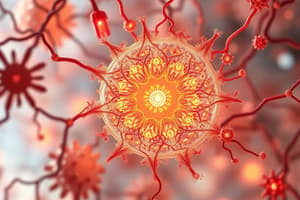Podcast
Questions and Answers
What is the nature of the Gibbs free energy change in cellular respiration?
What is the nature of the Gibbs free energy change in cellular respiration?
- Zero and endergonic
- Negative and spontaneous (correct)
- Positive and spontaneous
- Negative and endergonic
Which process requires energy input to convert ADP back into ATP?
Which process requires energy input to convert ADP back into ATP?
- ATP breakdown
- Photosynthesis
- ATP synthesis (correct)
- Glycolysis
What role does ATP play in biological systems?
What role does ATP play in biological systems?
- It functions as a structural component
- It stores genetic information
- It serves as the body's energy currency (correct)
- It acts as a signaling molecule
How is photosynthesis categorized in terms of Gibbs free energy?
How is photosynthesis categorized in terms of Gibbs free energy?
Which of the following statements about bioenergetics is true?
Which of the following statements about bioenergetics is true?
During the breakdown of ATP, what is released?
During the breakdown of ATP, what is released?
What is the primary source of energy for Earth?
What is the primary source of energy for Earth?
What type of process is cellular respiration?
What type of process is cellular respiration?
Which of the following best defines exergonic reactions?
Which of the following best defines exergonic reactions?
In the context of cellular functions, which of the following is true regarding ADP?
In the context of cellular functions, which of the following is true regarding ADP?
What role does sunlight play in energy acquisition for humans?
What role does sunlight play in energy acquisition for humans?
Which of the following describes Gibbs Free Energy?
Which of the following describes Gibbs Free Energy?
What indicates that a reaction is spontaneous according to Gibbs Free Energy?
What indicates that a reaction is spontaneous according to Gibbs Free Energy?
What type of reaction is photosynthesis classified as?
What type of reaction is photosynthesis classified as?
Which type of system can exchange energy but not mass with its surroundings?
Which type of system can exchange energy but not mass with its surroundings?
What is ATP primarily used for in the human body?
What is ATP primarily used for in the human body?
Which statement is true about cellular respiration?
Which statement is true about cellular respiration?
What best defines entropy?
What best defines entropy?
How can a positive value of Gibbs Free Energy be interpreted?
How can a positive value of Gibbs Free Energy be interpreted?
What critical function do humans require energy for?
What critical function do humans require energy for?
What does bioenergetics primarily study?
What does bioenergetics primarily study?
Which of the following characterizes Gibbs free energy when it is positive?
Which of the following characterizes Gibbs free energy when it is positive?
During ATP hydrolysis, what is produced along with ADP?
During ATP hydrolysis, what is produced along with ADP?
In photosynthesis, which of the following is a characteristic of reactants compared to the products?
In photosynthesis, which of the following is a characteristic of reactants compared to the products?
What is the primary role of ATP in living organisms?
What is the primary role of ATP in living organisms?
Which of the following describes the relationship between enthalpy and isolated systems?
Which of the following describes the relationship between enthalpy and isolated systems?
What type of reaction is cellular respiration classified as?
What type of reaction is cellular respiration classified as?
How does temperature factor into the Gibbs free energy equation?
How does temperature factor into the Gibbs free energy equation?
What is an example of a process requiring energy input according to Gibbs free energy?
What is an example of a process requiring energy input according to Gibbs free energy?
What is the primary energy currency of the human body?
What is the primary energy currency of the human body?
What type of system allows both mass and heat transfer?
What type of system allows both mass and heat transfer?
Which statement correctly describes a spontaneous process in terms of Gibbs free energy?
Which statement correctly describes a spontaneous process in terms of Gibbs free energy?
What is the measure of disorder within a system known as?
What is the measure of disorder within a system known as?
Which reaction type does photosynthesis exemplify?
Which reaction type does photosynthesis exemplify?
How is Gibbs free energy (ΔG) calculated?
How is Gibbs free energy (ΔG) calculated?
Which of the following processes decreases the entropy of a system?
Which of the following processes decreases the entropy of a system?
What is the definition of enthalpy (H)?
What is the definition of enthalpy (H)?
Which process is characterized as exergonic?
Which process is characterized as exergonic?
What is the effect of increasing temperature on entropy?
What is the effect of increasing temperature on entropy?
What are the two main categories of metabolism?
What are the two main categories of metabolism?
Which of the following compounds serves as the primary energy currency in the body?
Which of the following compounds serves as the primary energy currency in the body?
What is the product of anaerobic glycolysis?
What is the product of anaerobic glycolysis?
Which process occurs in the presence of oxygen and produces more energy than anaerobic pathways?
Which process occurs in the presence of oxygen and produces more energy than anaerobic pathways?
What primarily characterizes the function of protein in the body?
What primarily characterizes the function of protein in the body?
Which energy system does NOT require oxygen?
Which energy system does NOT require oxygen?
What molecule is produced during the breakdown of fats in beta oxidation?
What molecule is produced during the breakdown of fats in beta oxidation?
Which statement about protein catabolism is accurate?
Which statement about protein catabolism is accurate?
What is the main role of adenosine diphosphate (ADP) in ATP production?
What is the main role of adenosine diphosphate (ADP) in ATP production?
Which component is NOT involved in the production of ATP?
Which component is NOT involved in the production of ATP?
What is the main function of anabolic reactions?
What is the main function of anabolic reactions?
Which energy system primarily uses carbohydrates to produce energy anaerobically?
Which energy system primarily uses carbohydrates to produce energy anaerobically?
What is the role of ATP in the body?
What is the role of ATP in the body?
Which of the following statements about catabolic reactions is true?
Which of the following statements about catabolic reactions is true?
What is produced during the anaerobic breakdown of glucose?
What is produced during the anaerobic breakdown of glucose?
Which energy system requires oxygen for efficient energy production?
Which energy system requires oxygen for efficient energy production?
Which molecule is formed by the phosphorylation of ADP?
Which molecule is formed by the phosphorylation of ADP?
What percentage of energy does protein typically contribute during normal conditions?
What percentage of energy does protein typically contribute during normal conditions?
What process primarily oxidizes fatty acids to produce energy?
What process primarily oxidizes fatty acids to produce energy?
Which component is NOT part of the ATP molecule?
Which component is NOT part of the ATP molecule?
What type of reactions synthesize molecules by combining smaller molecules?
What type of reactions synthesize molecules by combining smaller molecules?
Which of these macronutrients primarily contributes to immediate energy production in muscle cells?
Which of these macronutrients primarily contributes to immediate energy production in muscle cells?
What process quickly regenerates ATP by breaking down phosphocreatine?
What process quickly regenerates ATP by breaking down phosphocreatine?
Which molecule serves as the primary energy currency in the body?
Which molecule serves as the primary energy currency in the body?
What is the main function of the Krebs cycle?
What is the main function of the Krebs cycle?
How much energy does protein release when broken down?
How much energy does protein release when broken down?
Which anaerobic process results in the production of lactate?
Which anaerobic process results in the production of lactate?
What happens during ADP phosphorylation?
What happens during ADP phosphorylation?
What is the typical contribution of protein catabolism to energy production?
What is the typical contribution of protein catabolism to energy production?
Which energy source is not typically recommended for energy production?
Which energy source is not typically recommended for energy production?
What is the primary role of anabolic reactions in metabolism?
What is the primary role of anabolic reactions in metabolism?
Which pathway occurs after glycolysis in the presence of oxygen?
Which pathway occurs after glycolysis in the presence of oxygen?
What is the main purpose of beta oxidation?
What is the main purpose of beta oxidation?
During which process is adenosine triphosphate (ATP) formed?
During which process is adenosine triphosphate (ATP) formed?
Which energy substrate is preferred by the body during exercise?
Which energy substrate is preferred by the body during exercise?
What does protein catabolism primarily contribute to during exercise?
What does protein catabolism primarily contribute to during exercise?
What distinguishes anaerobic pathways from aerobic pathways?
What distinguishes anaerobic pathways from aerobic pathways?
What is produced at the end of the glycolysis process under anaerobic conditions?
What is produced at the end of the glycolysis process under anaerobic conditions?
Which statement about ADP phosphorylation is correct?
Which statement about ADP phosphorylation is correct?
What is the primary component that makes up ATP?
What is the primary component that makes up ATP?
What process is primarily responsible for converting carbohydrates into energy during aerobic respiration?
What process is primarily responsible for converting carbohydrates into energy during aerobic respiration?
Which statement accurately describes anaerobic processes?
Which statement accurately describes anaerobic processes?
What is the primary energy currency produced during cellular metabolism?
What is the primary energy currency produced during cellular metabolism?
Which energy system is associated with the rapid replenishment of ATP in muscle cells?
Which energy system is associated with the rapid replenishment of ATP in muscle cells?
What is primarily produced during anaerobic glycolysis?
What is primarily produced during anaerobic glycolysis?
Why is protein not used as a primary energy source during exercise?
Why is protein not used as a primary energy source during exercise?
Which process converts fats into usable molecules for energy production?
Which process converts fats into usable molecules for energy production?
Which statement is true regarding the breakdown of proteins for energy?
Which statement is true regarding the breakdown of proteins for energy?
What type of metabolic reactions involve building larger molecules from smaller units?
What type of metabolic reactions involve building larger molecules from smaller units?
Which statement best describes ATP phosphorylation?
Which statement best describes ATP phosphorylation?
What type of reaction does anabolic metabolism involve?
What type of reaction does anabolic metabolism involve?
What is the primary energy molecule utilized by the body?
What is the primary energy molecule utilized by the body?
Which metabolic process ends with lactate production in the absence of oxygen?
Which metabolic process ends with lactate production in the absence of oxygen?
What is formed from pyruvate in the presence of oxygen?
What is formed from pyruvate in the presence of oxygen?
Which pathway is utilized to break down fats for energy?
Which pathway is utilized to break down fats for energy?
How much energy does one gram of protein yield approximately?
How much energy does one gram of protein yield approximately?
What is the role of ADP in ATP production?
What is the role of ADP in ATP production?
Where does the Krebs cycle take place within the cell?
Where does the Krebs cycle take place within the cell?
Which metabolic pathway does NOT require oxygen?
Which metabolic pathway does NOT require oxygen?
Which of the following statements about protein metabolism is correct?
Which of the following statements about protein metabolism is correct?
What is the primary function of anabolic reactions in metabolism?
What is the primary function of anabolic reactions in metabolism?
Which process is characterized as not requiring oxygen?
Which process is characterized as not requiring oxygen?
What is produced during anaerobic glycolysis?
What is produced during anaerobic glycolysis?
What does the process of ADP phosphorylation achieve?
What does the process of ADP phosphorylation achieve?
Which of the following best describes the main role of energy in biological systems?
Which of the following best describes the main role of energy in biological systems?
Which energy system primarily involves the quick replenishment of ATP stores?
Which energy system primarily involves the quick replenishment of ATP stores?
During which metabolic pathway does pyruvate enter the Krebs Cycle?
During which metabolic pathway does pyruvate enter the Krebs Cycle?
Which pathway is known for breaking down fats into energy-yielding compounds?
Which pathway is known for breaking down fats into energy-yielding compounds?
What is the main function of the electron transport chain in metabolism?
What is the main function of the electron transport chain in metabolism?
What role does protein primarily serve in metabolism?
What role does protein primarily serve in metabolism?
Flashcards
Bioenergetics
Bioenergetics
Transfer and use of energy in living things
Cellular Respiration
Cellular Respiration
A process that releases energy from glucose.
ATP
ATP
Body's energy currency
ATP
ATP
Signup and view all the flashcards
Gibbs Free Energy
Gibbs Free Energy
Signup and view all the flashcards
Sunlight Energy
Sunlight Energy
Signup and view all the flashcards
Gibbs Free Energy
Gibbs Free Energy
Signup and view all the flashcards
Endergonic
Endergonic
Signup and view all the flashcards
Exergonic
Exergonic
Signup and view all the flashcards
Exergonic Reaction
Exergonic Reaction
Signup and view all the flashcards
Endergonic Reaction
Endergonic Reaction
Signup and view all the flashcards
ATP Cycle
ATP Cycle
Signup and view all the flashcards
Photosynthesis
Photosynthesis
Signup and view all the flashcards
Photosynthesis
Photosynthesis
Signup and view all the flashcards
Bioenergetics
Bioenergetics
Signup and view all the flashcards
Cellular Respiration
Cellular Respiration
Signup and view all the flashcards
ADP
ADP
Signup and view all the flashcards
Open System
Open System
Signup and view all the flashcards
Inorganic phosphate
Inorganic phosphate
Signup and view all the flashcards
Gibbs Free Energy
Gibbs Free Energy
Signup and view all the flashcards
Bioenergetics
Bioenergetics
Signup and view all the flashcards
ATP
ATP
Signup and view all the flashcards
Gibbs Free Energy (ΔG)
Gibbs Free Energy (ΔG)
Signup and view all the flashcards
Endergonic (ΔG > 0)
Endergonic (ΔG > 0)
Signup and view all the flashcards
Exergonic (ΔG < 0)
Exergonic (ΔG < 0)
Signup and view all the flashcards
Photosynthesis
Photosynthesis
Signup and view all the flashcards
Cellular Respiration
Cellular Respiration
Signup and view all the flashcards
ATP Hydrolysis
ATP Hydrolysis
Signup and view all the flashcards
Enthalpy (ΔH)
Enthalpy (ΔH)
Signup and view all the flashcards
Entropy (ΔS)
Entropy (ΔS)
Signup and view all the flashcards
Bioenergetics
Bioenergetics
Signup and view all the flashcards
Gibbs Free Energy (ΔG)
Gibbs Free Energy (ΔG)
Signup and view all the flashcards
Endergonic Reaction
Endergonic Reaction
Signup and view all the flashcards
Exergonic Reaction
Exergonic Reaction
Signup and view all the flashcards
Photosynthesis
Photosynthesis
Signup and view all the flashcards
Cellular Respiration
Cellular Respiration
Signup and view all the flashcards
Enthalpy (ΔH)
Enthalpy (ΔH)
Signup and view all the flashcards
Entropy (ΔS)
Entropy (ΔS)
Signup and view all the flashcards
ATP
ATP
Signup and view all the flashcards
Spontaneous Reaction
Spontaneous Reaction
Signup and view all the flashcards
Metabolism
Metabolism
Signup and view all the flashcards
Anabolic Reaction
Anabolic Reaction
Signup and view all the flashcards
Catabolic Reaction
Catabolic Reaction
Signup and view all the flashcards
Bioenergetics
Bioenergetics
Signup and view all the flashcards
ATP
ATP
Signup and view all the flashcards
Anaerobic Systems
Anaerobic Systems
Signup and view all the flashcards
Aerobic Systems
Aerobic Systems
Signup and view all the flashcards
Beta Oxidation
Beta Oxidation
Signup and view all the flashcards
Protein Energy Contribution
Protein Energy Contribution
Signup and view all the flashcards
ATP production
ATP production
Signup and view all the flashcards
Metabolism
Metabolism
Signup and view all the flashcards
Anabolic Reaction
Anabolic Reaction
Signup and view all the flashcards
Catabolic Reaction
Catabolic Reaction
Signup and view all the flashcards
Bioenergetics
Bioenergetics
Signup and view all the flashcards
ATP
ATP
Signup and view all the flashcards
ADP Phosphorylation
ADP Phosphorylation
Signup and view all the flashcards
Anaerobic Systems
Anaerobic Systems
Signup and view all the flashcards
Beta Oxidation
Beta Oxidation
Signup and view all the flashcards
Protein Contribution to Energy
Protein Contribution to Energy
Signup and view all the flashcards
Aerobic Systems
Aerobic Systems
Signup and view all the flashcards
Metabolism
Metabolism
Signup and view all the flashcards
Anabolic Reactions
Anabolic Reactions
Signup and view all the flashcards
Catabolic Reactions
Catabolic Reactions
Signup and view all the flashcards
ATP
ATP
Signup and view all the flashcards
ATP Production
ATP Production
Signup and view all the flashcards
Anaerobic Glycolysis
Anaerobic Glycolysis
Signup and view all the flashcards
Aerobic Systems
Aerobic Systems
Signup and view all the flashcards
Beta Oxidation
Beta Oxidation
Signup and view all the flashcards
Protein Energy Contribution
Protein Energy Contribution
Signup and view all the flashcards
Immediate Energy Source (ATP)
Immediate Energy Source (ATP)
Signup and view all the flashcards
Metabolism
Metabolism
Signup and view all the flashcards
Anabolic Reactions
Anabolic Reactions
Signup and view all the flashcards
Catabolic Reactions
Catabolic Reactions
Signup and view all the flashcards
Bioenergetics
Bioenergetics
Signup and view all the flashcards
ATP
ATP
Signup and view all the flashcards
Anaerobic Pathways
Anaerobic Pathways
Signup and view all the flashcards
Aerobic Pathways
Aerobic Pathways
Signup and view all the flashcards
Beta Oxidation
Beta Oxidation
Signup and view all the flashcards
Protein Energy Contribution
Protein Energy Contribution
Signup and view all the flashcards
ADP Phosphorylation
ADP Phosphorylation
Signup and view all the flashcards
Metabolism
Metabolism
Signup and view all the flashcards
Bioenergetics
Bioenergetics
Signup and view all the flashcards
ATP
ATP
Signup and view all the flashcards
Anaerobic Processes
Anaerobic Processes
Signup and view all the flashcards
Aerobic Processes
Aerobic Processes
Signup and view all the flashcards
Glycolysis
Glycolysis
Signup and view all the flashcards
Beta Oxidation
Beta Oxidation
Signup and view all the flashcards
Protein Energy Contribution
Protein Energy Contribution
Signup and view all the flashcards
ADP Phosphorylation
ADP Phosphorylation
Signup and view all the flashcards
Carbohydrate Breakdown
Carbohydrate Breakdown
Signup and view all the flashcards
Metabolism
Metabolism
Signup and view all the flashcards
Anabolic Reactions
Anabolic Reactions
Signup and view all the flashcards
Catabolic Reactions
Catabolic Reactions
Signup and view all the flashcards
ATP
ATP
Signup and view all the flashcards
Anaerobic Processes
Anaerobic Processes
Signup and view all the flashcards
Aerobic Processes
Aerobic Processes
Signup and view all the flashcards
Beta Oxidation
Beta Oxidation
Signup and view all the flashcards
Protein Energy Contribution
Protein Energy Contribution
Signup and view all the flashcards
Glycolysis
Glycolysis
Signup and view all the flashcards
ADP Phosphorylation
ADP Phosphorylation
Signup and view all the flashcards
Metabolism
Metabolism
Signup and view all the flashcards
Anabolic Reactions
Anabolic Reactions
Signup and view all the flashcards
Catabolic Reactions
Catabolic Reactions
Signup and view all the flashcards
Bioenergetics
Bioenergetics
Signup and view all the flashcards
ATP
ATP
Signup and view all the flashcards
Anaerobic Processes
Anaerobic Processes
Signup and view all the flashcards
Aerobic Processes
Aerobic Processes
Signup and view all the flashcards
Glycolysis
Glycolysis
Signup and view all the flashcards
Beta Oxidation
Beta Oxidation
Signup and view all the flashcards
Protein Energy Contribution
Protein Energy Contribution
Signup and view all the flashcards
Study Notes
Bioenergetics
- Bioenergetics describes the transfer and utilization of energy in biological systems; this involves processes within living organisms.
- Energy is defined as the capacity for doing work.
- Humans need energy for crucial functions like walking, growing, development, and even basic processes like breathing and heart beating.
Sunlight as the Primary Energy Source
- Sunlight is the main energy source for Earth.
- Plants, using photosynthesis, convert sunlight energy into glucose.
- Animals eat plants, or other animals that eat plants.
- Humans obtain energy from consuming plants and animals, indirectly using sunlight energy.
ATP: The Body's Energy Currency
- ATP (Adenosine Triphosphate) is the energy source used by the human body.
- ATP contains high-energy bonds between its phosphate groups.
- When these bonds break, energy is released.
Gibbs Free Energy
- Gibbs Free Energy (also called Free Energy) is the amount of energy in a system available to do work.
- It predicts whether a process will occur spontaneously or require external energy input.
- A negative Gibbs free energy indicates a spontaneous process.
- A positive Gibbs free energy indicates a non-spontaneous process requiring energy input.
Enthalpy and Entropy
- Enthalpy is the total internal energy of a system.
- Entropy is a measure of disorder or randomness within a system.
Types of Systems
- Open Systems: can exchange both mass and energy with their surroundings.
- Closed Systems: can exchange energy but not mass with their surroundings.
- Isolated Systems: can exchange neither mass nor energy with their surroundings.
- Isolated systems have the highest enthalpy.
- Real-life examples of completely isolated systems are rare.
Gibbs Free Energy and Reactions
- Negative Gibbs free energy indicates an exergonic reaction, which releases energy and occurs spontaneously.
- Positive Gibbs free energy indicates an endergonic reaction, which requires energy input and is not spontaneous.
Photosynthesis: An Endergonic Reaction
- Photosynthesis takes in carbon dioxide (CO₂ ) and water (H₂O) and uses sunlight to produce glucose and oxygen (O₂).
- Photosynthesis has a positive Gibbs free energy, meaning it requires energy input (from sunlight).
Cellular Respiration: An Exergonic Reaction
- Cellular Respiration breaks down glucose, which is produced by photosynthesis, into CO₂ and H₂O to release energy in the form of ATP.
- Cellular Respiration has a negative Gibbs free energy, meaning it is spontaneous and releases energy.
ATP Cycle
- Breaking down ATP into ADP and inorganic phosphate releases energy (exergonic).
- Converting ADP back into ATP requires energy input (endergonic).
Summary
- Bioenergetics links the transfer of energy and its utilization in biological systems.
- Sunlight is the primary energy source for Earth and its inhabitants, powering processes like photosynthesis.
- ATP is the body's energy currency, used to fuel various functions.
- Gibbs Free Energy predicts the spontaneity of chemical processes, which can be categorized as endergonic (requiring energy) or exergonic (releasing energy).
- Photosynthesis is an endergonic process generating glucose.
- Cellular Respiration is an exergonic process that uses glucose to release energy.
Studying That Suits You
Use AI to generate personalized quizzes and flashcards to suit your learning preferences.




